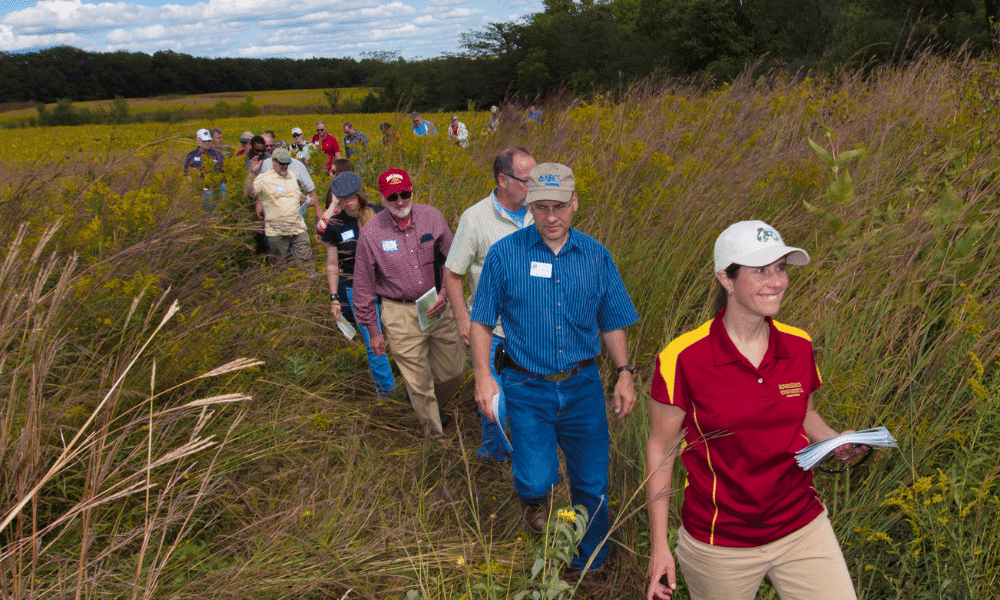
Lisa Schulte Moore of ISU leads a group of farmers, scientists and prairie enthusiasts through a prairie strip in the foot slope of a soybean field by the Neal Smith National Wildlife Refuge near Prairie City. (Photo: Iowa Soybean Association)
Prairie strips are a win-win-win for farmers, communities and the environment
May 5, 2021
By Sean McMahon, Iowa Agriculture Water Alliance Executive Director
Every field has its trouble spots; those places within the field that the yield monitor will dip as farmers pass over them in the combine; the low spots that are too wet most years, the eroded hill tops and side hills, the sandy ridges, or the compacted turning headlands.
One company that pioneered sub-field scale profitability analysis found within every single field analyzed, 3% to 20% of those acres lost big money at least four out of five years.
What if there was a way to flip the script on those acres? How would you like to go from losing more than $300/ acre in one of those problem spots to getting paid $300/acre?
What if you were able to replace one or more of those trouble spots where you lose good money on expensive inputs with tall, noble, native prairie grasses; beautiful Iowa prairie flowers, monarchs and other butterflies, Goldfinches and other songbirds, and beneficial insects and pollinators?
What if those problematic places within your field became new places where you can delight in the beauty of God’s creation and nature’s bountiful palette of colors, as well as more green in your wallet?
Well, there is. Meet your new friend. You can call her “Prairie Strips.”
Iowa State University (ISU) has spent the better part of the last 15 years perfecting placing strips of prairie in those problem spots within fields where they can do the most good for both farmers and nature. By replacing approximately 5% of your field acres where you currently lose money most years, you can cut your water run-off by 42%, reduce your soil erosion sediment loss by 95%; and nearly eliminate your nitrogen and phosphorus losses by 70% and 77%, respectively.
Prairie strips hold back the soil, water and nutrients for other parts of your fields while improving water quality. And they create important habitat for butterflies, pollinators and beneficial insects that are the enemies of crop pests and several bird species. Best of all, ISU partners with farmers to put prairie strips where they make the most sense in terms of farm operability and profitability.
Ryan Kay, an accredited farm manager and land consultant for Hertz Farm Management, has helped multiple clients incorporate prairie strips and has even done so on his family farm. Kay says, “prairie strips are a flexible tool for improving farming efficiencies within the field.
“We have designed prairie strips to reduce turn rows, establish buffers by timber, and reduce erosion in specific field locations,” says Kay. “This allows us to farm the productive regions of the field and create diversity while keeping conservation in mind.
He encourages landowners and farmers to look at areas within the field that are susceptible to compaction, erosion and water flow to incorporate prairie strips.
By reducing expenses and ceasing to throw good money after bad, farmers have more resources available to allocate to zones of the field that generate the highest productivity and profitability.
Thanks to the 2018 Farm Bill, which mentions prairie strips by name, this important practice pioneered right here in Iowa is now available through the Conservation Reserve Program (CRP). It has been implemented in 13 states. Iowa NRCS is making cost-share available for farmers for this exciting and innovative conservation practice through the Environmental Quality Incentives Program (EQIP).
“Prairie strips provide a great opportunity for our farmers to produce crops and environmental benefits at the same time.
“With the appropriate cost-share to offset expenses, farmers can also increase profitability,” notes Iowa NRCS State Conservationist Jon Hubbert.
A generous grant from the CropLife Foundation is helping ISU and the Iowa Wildlife Federation partner with farmers and landowners to scale up adoption of prairie strips in Iowa and beyond.
“CropLife America is excited to work with the Iowa Agriculture Water Alliance (IAWA) and the CropLife Foundation to promote prairie strips and the Precision Prairie project,” says Chris Novak, CropLife America president and CEO.
“The practice of returning non-productive parts of the field to native grasslands not only provides habitat for pollinators and other wildlife species, it also helps farmers increase ROI while enhancing environmental sustainability. Prairie strips offer a win-win that helps farmers produce food more sustainably and profitably on less land, using fewer resources.”
IAWA is coordinating the CropLife Foundation grant and its grantees to raise awareness for prairie strips.
“We’re thankful for the Croplife Foundation’s and Iowa Wildlife Federation’s help in increasing the pace and scale of farmland conservation in Iowa,” notes Dr. Lisa Schulte Moore, ISU professor of natural resources ecology and management, who helped create the prairie strips concept.
“We have a real opportunity to show the world what agriculture that works for both people and the land looks like.”
This story was originally published in the Spring 2021 issue of the Iowa Soybean Review.
Back